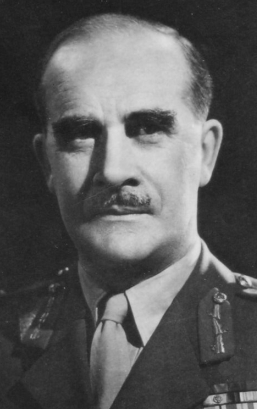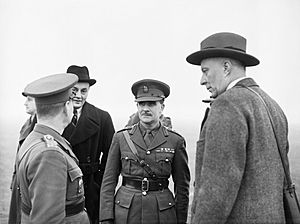Colin Gubbins facts for kids
Quick facts for kids
Colin McVean Gubbins
|
|
|---|---|

Sir Colin Gubbins c.1940s
|
|
| Born | 2 July 1896 Tokyo, Japan |
| Died | 11 February 1976 (aged 79) Stornoway, Lewis, Scotland |
| Allegiance | United Kingdom |
| Service/ |
British Army |
| Years of service | 1914–1946 |
| Rank | Major-General |
| Service number | 14618 |
| Unit | Royal Field Artillery |
| Commands held | 24th Guards Brigade (1940) Auxiliary Units (1940) Special Operations Executive (1943–1946) |
| Battles/wars | First World War North Russia Campaign Anglo-Irish War Second World War |
| Awards | Knight Commander of the Order of St Michael and St George Distinguished Service Order Military Cross |
Major-General Sir Colin McVean Gubbins (2 July 1896 – 11 February 1976) was a very important British Army officer. He is best known for leading the Special Operations Executive (SOE) during the Second World War.
Gubbins also created the secret Auxiliary Units. This was a special commando group. It was made up of Home Guard members. Their job was to fight behind enemy lines if United Kingdom was invaded by Germany.
Contents
Early Life and Education
Colin Gubbins was born in Japan on July 2, 1896. His father worked for the British government there. When he was young, he lived with his grandparents in Scotland.
He went to Cheltenham College and then to the Royal Military Academy in Woolwich. This is where he trained to become an army officer.
Military Career
First World War Hero
Gubbins joined the Royal Field Artillery in 1914. This was just before the First World War began. He was in Germany learning the language when the war started. He had to travel quickly back to Britain.
He fought on the Western Front. This was a major battle area in France and Belgium. He first saw action in May 1915. He was promoted to lieutenant soon after.
In July 1916, he fought in the Battle of the Somme. He was awarded the Military Cross for bravery. He rescued wounded soldiers while under fire. He was wounded himself but recovered. He also fought in the Battle of Arras. Later, he was affected by mustard gas. In 1918, he was promoted to captain. He then fought in the Battle of St Quentin.
Between the World Wars
After the First World War, Gubbins served in Russia in 1919. He was part of a British mission there. His experiences made him strongly dislike certain political ideas.
He then went to Ireland in 1919. He was an intelligence officer during the Irish War of Independence. He learned a lot about guerrilla warfare. This is a type of fighting where small groups use surprise attacks. He later said he admired Michael Collins, an Irish leader, for his skills in this type of fighting.
His time in Russia and Ireland made him very interested in unusual fighting methods. He learned that keeping secrets was very important. He believed that soldiers should write down as little as possible. They should burn all secret papers.
Gubbins continued his military education. He also worked on writing training manuals. These manuals were about how to fight in irregular ways. They were later used to help resistance movements in Europe. He also visited Poland to talk about sabotage.
Second World War and Secret Operations
When the Second World War began in 1939, Gubbins went to Poland. He saw how effective German tanks were. After returning to Britain, he created the Independent Companies. These were early versions of the British Commandos.
He commanded these new units in Norway in 1940. He showed great courage and skill as a leader. He was awarded the Distinguished Service Order for his actions there.
Back in Britain, he was asked to form the secret Auxiliary Units. These were special commando groups. They were made up of Home Guard members and army teams. Their job was to fight behind German lines if Britain was invaded.

In November 1940, Gubbins joined the Special Operations Executive (SOE). This was a new secret organization. Its goal was to "coordinate all action by way of sabotage and subversion against the enemy overseas." This meant causing trouble for the enemy in occupied countries.
Gubbins had three main tasks at SOE:
- Set up training places for agents.
- Create ways for agents to work with the Navy and Air Force.
- Work closely with other military planners.
He faced many challenges, especially with getting enough aircraft. But he kept training and sending agents into the field. The first flight to Poland happened in 1941. By 1942 and 1943, resistance groups helped by SOE had big successes. One famous success was a raid on a heavy water plant in Norway. This plant was important for Germany's nuclear research.
Gubbins also helped create the "Shetland Bus." This was a regular boat link between the Shetland Islands and Norway. It helped send saboteurs and explosives into Norway.
In 1943, Gubbins became the head of SOE. He was in charge of resistance movements all over the world. He worked with other important groups, including the US Office of Strategic Services (OSS).
The organized resistance movements were very effective. General Dwight D. Eisenhower, a top Allied commander, said that the French Resistance alone was as helpful as six army divisions. This shows how important Gubbins' work was.
Later Life
After the war, SOE was closed down in 1946. Gubbins left the army and became a managing director for a carpet company. He stayed in touch with people from the countries he had helped free. He also helped start the Special Forces Club.
Personal Life
Colin Gubbins married Norah Creina in 1919. They had two sons. Their elder son, Michael, also served in the SOE. Sadly, Michael was killed in Italy in 1944. Gubbins later married Anna Elise Tradin in 1950.
Death
Gubbins loved shooting and fishing. He spent his last years at his home in Scotland. He died in Stornoway on February 11, 1976.
Legacy
Many people have praised Gubbins for his work. Andrew Roberts and Niall Ferguson, two historians, called him "one of the war's unsung heroes." This means he was a hero whose important work was not always recognized.
See also
- Edmund Charaszkiewicz
- Jan Kowalewski
- Krystyna Skarbek

